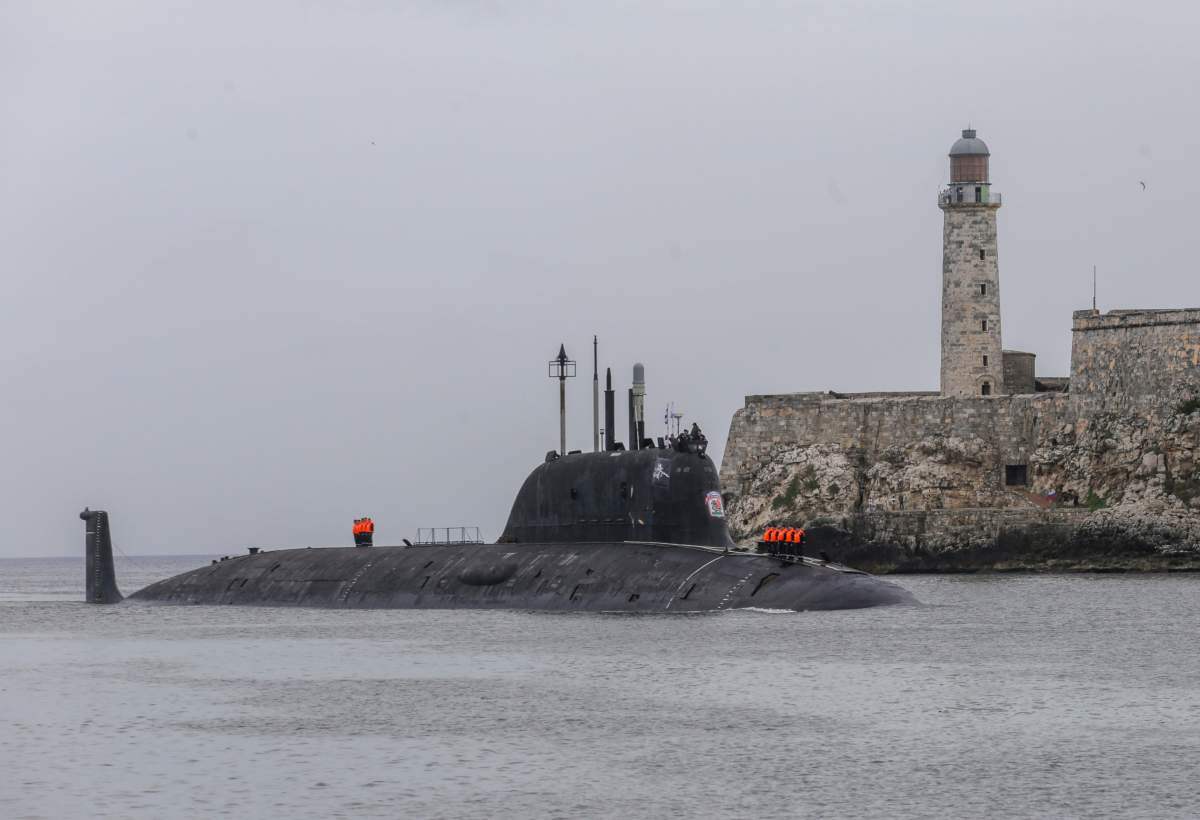A Russian navy frigate and a nuclear-powered submarine churned into Havana harbor on Wednesday, a stopover the U.S. and Cuba said posed no threat but which was widely seen as a Russian show of force as tensions rise over the Ukraine war.

Curious onlookers, fishermen and police lined the Malecon seafront boulevard under gray skies to welcome the ships as they passed the 400-year old Morro castle at the harbor’s entrance.
Cuba – a long-time ally of Russia – saluted the ships’ arrival with cannon fire from the harbor, while Russian diplomats waved small Russian flags and took selfies as the vessels passed the harbor’s historic fortresses.
The Admiral Gorshkov frigate, and later the nuclear-powered submarine Kazan, half submerged with its crew on deck, were accompanied by a tugboat and fuel ship that had arrived earlier in the morning.
The four Russian vessels sailed to Cuba on Wednesday after conducting “high-precision missile weapons” training in the Atlantic Ocean, Russia’s defense ministry said Wednesday.
The submarine and frigate carry Zircon hypersonic missiles, Kalibr cruise missiles and Onyx anti-ship missiles, the ministry said.
Cuba said last week that the visit was standard practice by naval vessels from countries friendly to Havana. The communist-run government’s foreign ministry said the fleet carried no nuclear weapons, something echoed by U.S. officials.
The U.S. has been monitoring the Russian vessels as they skirted the nearby Florida coast, but has said they pose no threat.

Get daily National news
White House national security adviser Jake Sullivan told reporters on Wednesday such naval exercises were routine.
“We have seen this kind of thing before and we expect to see this kind of thing again, and I’m not going to read into it any particular motives,” Sullivan said.
Sullivan said there was no evidence of Russia transferring any missiles to Cuba, but the U.S. would remain vigilant.
“We do not expect anything like that to occur.”
Power play
Havana is just 100 miles (160 km) from Key West, Florida, home to a U.S. Naval Air Station. The timing of the visit – as the Biden administration ponders how far to go in helping defend Ukraine against Russia – suggests more than “standard practice,” said William Leogrande, a professor at American University.
“The visiting Russian warships are Putin’s way of reminding Biden that Moscow can challenge Washington in its own sphere of influence,” Leogrande said.

The stopover coincides with Cuba’s worst social and economic crisis in decades, with shortages of everything from food, medicine and fuel and growing discontent on the streets.
“This … has echoes of the Cold War, but unlike the first Cold War, the Cubans are drawn to Moscow not by ideological affinity but by economic necessity,” Leogrande said.
History looms large in Cuba, especially when it comes to Russia and its predecessor the Soviet Union.
The Cuban missile crisis erupted in 1962 when the Soviet Union responded to a U.S. missile deployment in Turkey by sending ballistic missiles to Cuba, sparking a standoff that brought the world to the brink of nuclear war.
The two countries are once again strengthening ties.
Cuban President Miguel Diaz-Canel visited Russian President Vladimir Putin for the fourth time in May, when he attended a military parade, wished Russian forces well in Ukraine and said Moscow could always count on Havana’s support.
Russia in March delivered 90,000 metric tons of Russian oil to Cuba to help alleviate shortages, and has promised to help Havana in projects ranging from sugar production to infrastructure, renewable energy and tourism.
The history between the two nations was not lost on many of the Cubans who watched the Russian ships’ arrival.
“I have never seen a ship of that size so close,” said María Isabel Quesada, 50, of nearby Old Havana. “As a Cuban I feel safe, I feel satisfied … confident in having a very beautiful relationship between our countries.”
The Russian ships are expected to remain in Havana until June 17.
- RCMP say Haitian migrants including 3-year-old, intercepted in Quebec near border
- Indonesian rescuers search for a Spanish coach and 3 children after tour boat sinks
- ‘The year that the shoe dropped’: Canada-U.S. relationship in 2025
- Nigerians react after U.S. airstrikes targeting alleged Islamic State camp









Comments